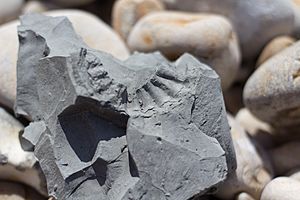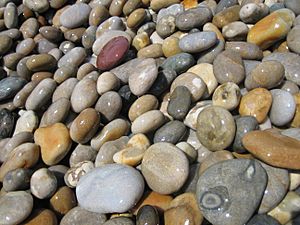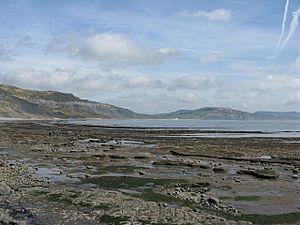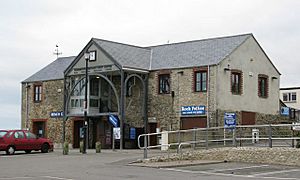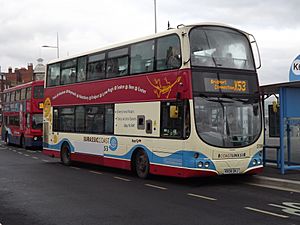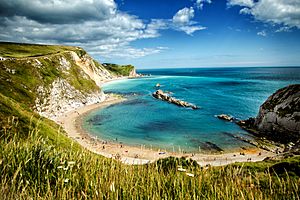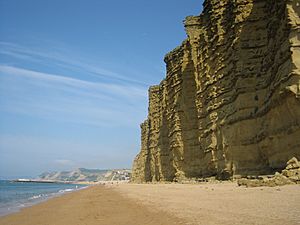Jurassic Coast facts for kids
| UNESCO World Heritage Site | |
|---|---|
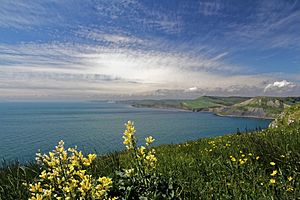
The Jurassic Coast west of St Aldhelm's Head
|
|
| Location | United Kingdom |
| Criteria | Natural: viii |
| Inscription | 2001 (25th Session) |
The Jurassic Coast is a special World Heritage Site found on the coast of southern England, along the English Channel. It stretches for about 96 miles (155 km) from Exmouth in East Devon to Studland Bay in Dorset. This amazing coastline was added to the World Heritage List in 2001.
This area shows 185 million years of Earth's history! Over time, the coast has been worn away by the sea, revealing layers of rock from the Triassic, Jurassic, and Cretaceous periods. Long ago, this place was a desert, then a warm tropical sea, and even a swamp. The fossils of ancient creatures that lived here are still preserved in the rocks.
Along the coast, you can see cool natural shapes like arches, tall rock pillars, and sea stacks. In some spots, the sea has broken through tough rocks to create hidden coves with small entrances. The Isle of Portland is even connected to the mainland by a narrow strip of land. Sometimes, large sections of the cliff slide down, which is called a landslide. These landslides often reveal even more fossils, showing how plants and animals changed over millions of years.
Near Lulworth Cove, you can find a fossil forest. At Lyme Regis, scientists have found 71 different rock layers, each with its own type of ammonite fossil. A famous fossil hunter named Mary Anning lived here. Her amazing discoveries of sea reptiles and other fossils helped start the study of palaeontology, which is the study of ancient life. You can learn more about the coast at the Charmouth Heritage Coast Centre. You can also walk the entire length of the site on the South West Coast Path.
Contents
What is the Jurassic Coast?
The Jurassic Coast runs from Orcombe Point near Exmouth in East Devon to Old Harry Rocks near Swanage in East Dorset. This distance is about 96 miles (155 km). In 2001, it became the first completely natural World Heritage Site in the United Kingdom. At Orcombe Point, there's a special pointy sculpture called the "Geoneedle." It's made from pieces of all the different rocks found along the coast, marking the western end of this amazing place.
The cliffs along this coast are always changing. Sections crumble away, and landslides happen. These natural processes reveal new layers of rock, showing us 185 million years of Earth's history. You can see rocks from the Triassic, Jurassic, and Cretaceous periods. The fossils and coastal features here have helped scientists learn about our planet for over 200 years.
Discovering Ancient Life: Fossils!
Many fossils are found along this coastline. They show how animals and plants evolved in this area. During the Triassic period, this region was a hot desert. In the Jurassic period, it was part of a warm tropical sea. Later, in the Cretaceous period, it was covered by swamps. The fossilized remains of the creatures from these times are very well preserved. They give us clues about their bodies, how they died, and even what they ate!
Fossils found here include crustaceans (like crabs), insects, molluscs (like snails), echinoderms (like starfish), fish, amphibians, reptiles, and even some mammals. At Lulworth Cove, you can see a fossil forest with ancient conifers, tree-ferns, and cycads.
Mary Anning: Fossil Hunter Extraordinaire
Some of the most important fossil discoveries were made right here!
- The first complete ichthyosaur skeleton
- The first plesiosaur skeleton
- The first pterosaur found outside Germany
These amazing finds were made by Mary Anning in the early 1800s. Mary lived in Lyme Regis. She was a dedicated collector who searched the coastline for fossils. Her discoveries helped scientists understand much more about prehistoric life.
Incredible Rock Formations
The Jurassic Coast has many unique natural features. These include the famous natural arch called Durdle Door. You can also see the beautiful cove and folded limestone rocks at Lulworth Cove. The Isle of Portland is another special feature, connected to the mainland by a narrow strip of land.
Chesil Beach is one of England's three main shingle (gravel) beaches. It's a long barrier beach that runs next to the coastline and connects to Portland Bill. Behind this barrier beach, there's a calm lagoon. Golden Cap is the highest point on the south coast of England, standing 191 meters (627 feet) tall.
The many layers of rock along this coast are full of fossils. These are the remains of ancient animals and plants that were covered by mud, which later turned into rock. For example, at Lyme Regis, scientists have found 71 different layers of rock, and each one contains fossils of a different type of ammonite!
A Look Back in Time: History of the Coast
In the late 1700s, a scientist named Georges Cuvier showed that some fossil animals were unlike any living animals. This proved that animals could become extinct. This idea helped start the study of palaeontology, which is all about fossils. The coasts of eastern Devon and western Dorset were rich in fossils. But before this time, people just collected them for fun or sold them as souvenirs.
Mary Anning (1799–1847) lived in Lyme Regis. She followed in her father's footsteps as a fossil collector. She became an expert on the fossils found in the Blue Lias rocks around her town. She even discovered the first complete Ichthyosaur skeleton at a place called The Spittles.
During World War II, some parts of the Jurassic Coast became military land. Today, some areas, like the coast between Lulworth Cove and Kimmeridge, are still not fully open to the public. This includes the old village of Tyneham, which was emptied in 1943 for army training.
Parts of the coast, especially around Portland, can be dangerous for ships. Sometimes, ships have gotten into trouble here. In 2007, a large container ship called the MSC Napoli ran aground near Branscombe, causing some oil and cargo to spill.
Exploring and Protecting the Coast
The Jurassic Coast can experience very strong storms. These storms can damage the cliffs and cause flooding in coastal towns. The coast is naturally eroding, meaning it's always being worn away by the sea. The people who manage the site try to let these natural processes continue. However, they also protect people and buildings where needed. For example, coastal defenses have been built in Charmouth and Weymouth to protect houses. But in other natural areas, they let erosion happen on its own.
The Charmouth Heritage Coast Centre is a special place near Charmouth beach. It's a charity that teaches people about the geology and wildlife of the area. They have a large collection of fossils and even a rock-pool aquarium. You can join family fossil-hunting trips and other fun activities there.
You can walk the entire length of the coast on the South West Coast Path. Landslides and rockfalls are a normal part of how this coast changes. In 2008, a huge section of the coast, about 1,300 feet (400 meters) long, changed dramatically after a landslide. More cliff falls happened in 2012 at Burton Bradstock and in 2016 at West Bay.
Towns to Visit Along the Coast
These are some of the special towns connected to the Jurassic Coast:
- Weymouth
- West Bay
- Abbotsbury
- Bridport
- Budleigh Salterton
- Charmouth — home to the Charmouth Heritage Coast Centre
- Exmouth
- Lulworth
- Lyme Regis
- Seaton
- Sidmouth
- Swanage
Related pages
Images for kids
-
The Jurassic Coast west of St Aldhelm's Head
See also
 In Spanish: Costa Jurásica para niños
In Spanish: Costa Jurásica para niños



